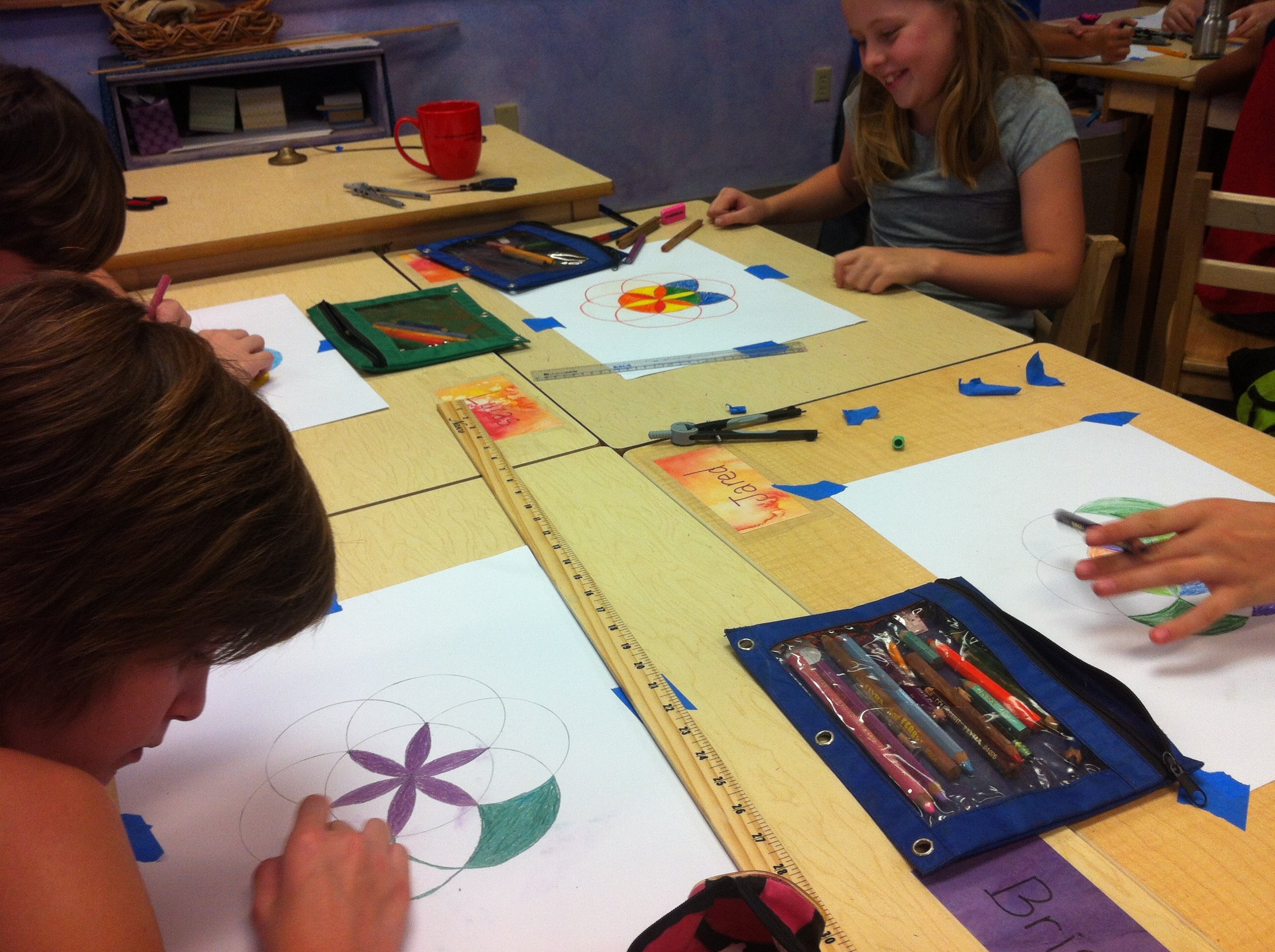6th Grade Geometry Intro, Waldorf-style!
One of the first things I did as a Waldorf Classroom Teacher was to begin a block on geometry with my new group of 6th graders. I happen to be flipping through old pictures, and found these treasures. I hope they help you!Geometry, in a Waldorf setting, really begins as early as Kindergarten, though we don't mention it to the kids. Every time we form a circle for story time, making certain that everyone can see, that there's a single, perfect row of chairs or spaces around the carpet, etc, we're reinforcing the geometric rules of play. This moves into form drawing in the first grade, and carries them through the grades, creating beautiful geometric patters and flowing forms. It isn't until Sixth Grade that we finally add tools of precision to their task: the straight edge and compass.When I began my Geometric Form Drawing block, fresh from summer break, and without proper training (WHAT?!?!?! How did I survive?...), I began by leading the class through the importance of rules, and precision. We talked about what the rules of the classroom were, how to follow them, and what consequences would ensue if the were broken.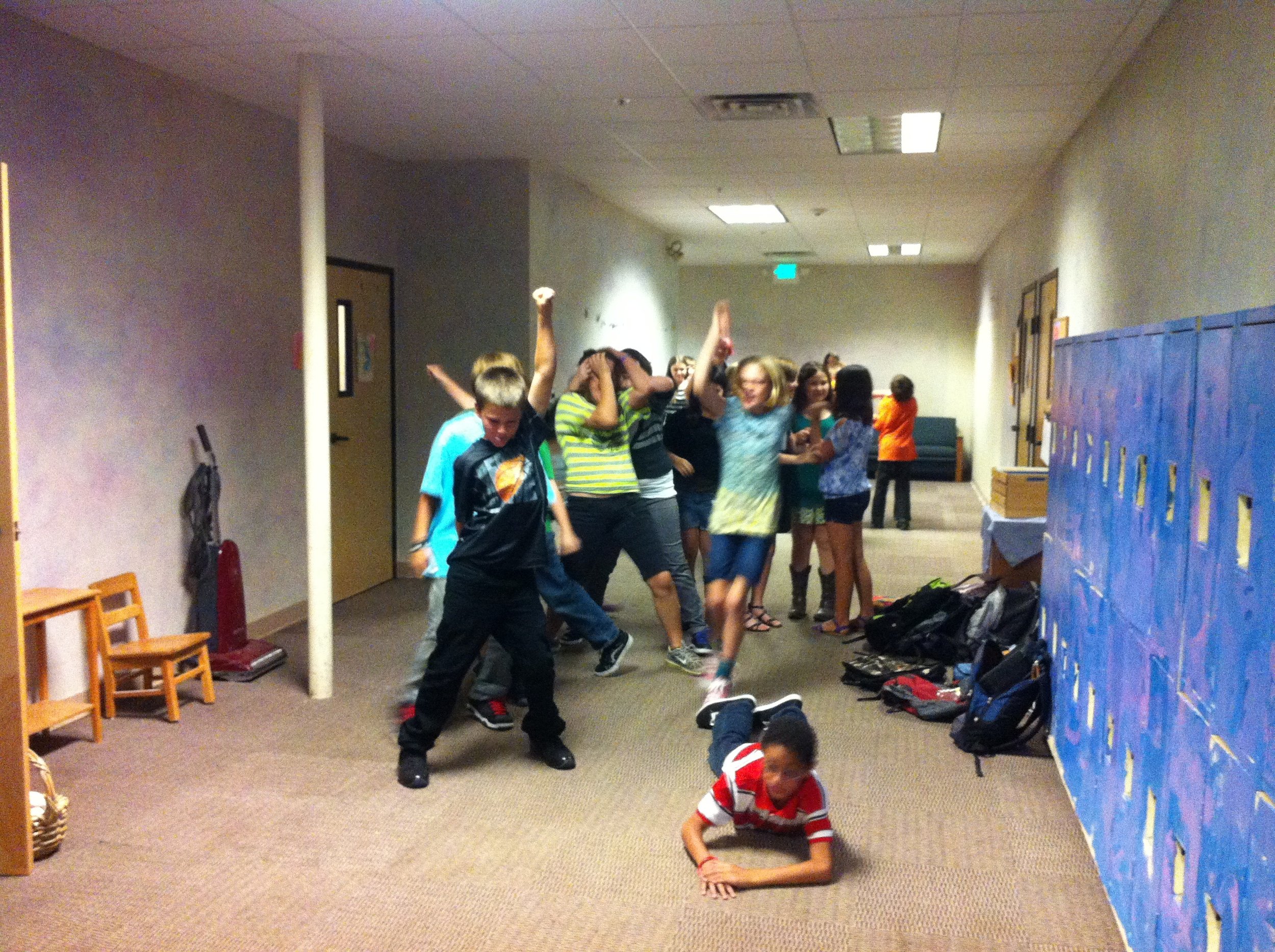
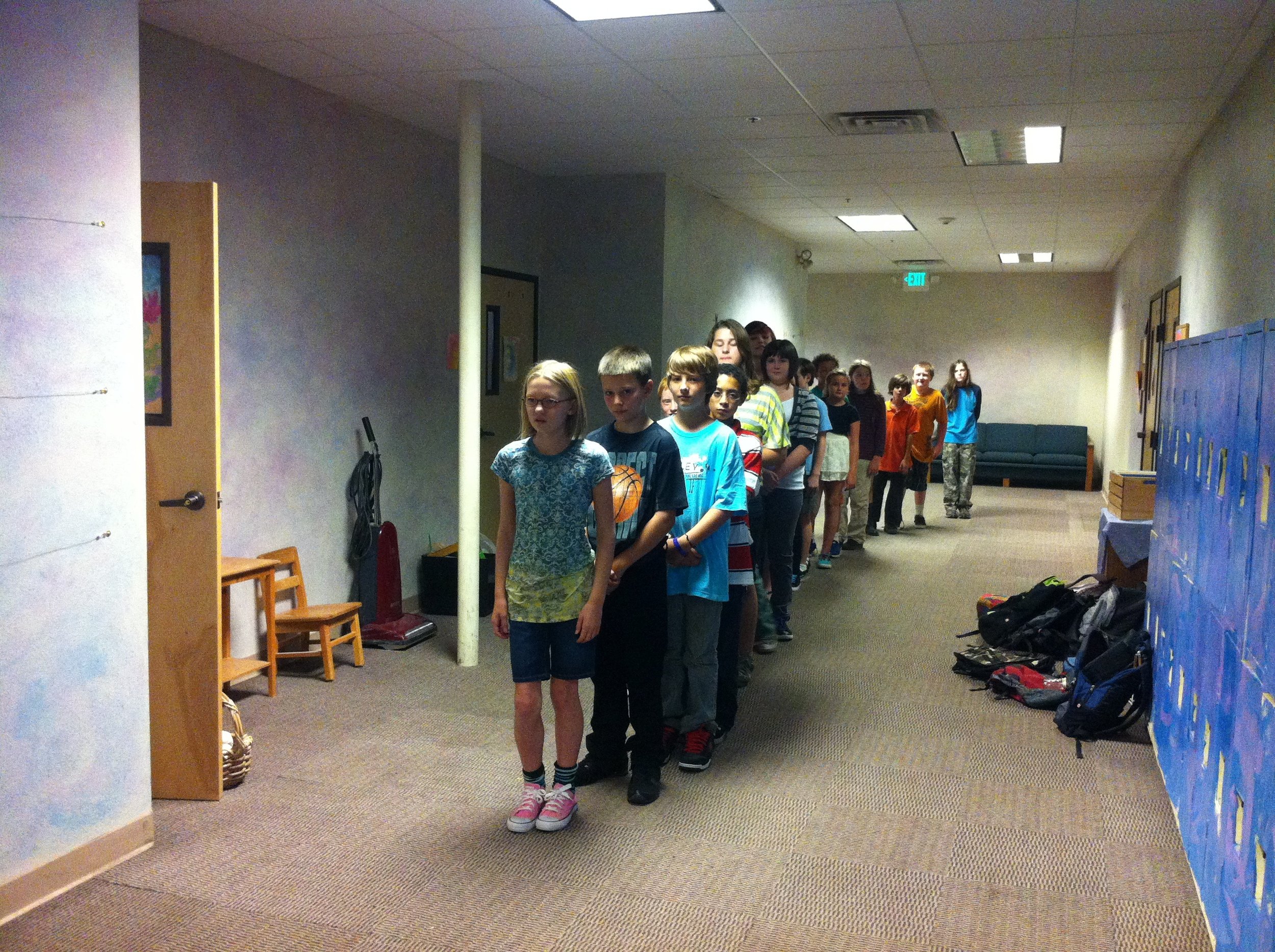 Then, we practiced the rules! We created glorious, loud, raucous chaos in the room as they listened intently for my bell, the signal for quiet, and attention. It was really fun! We also practiced shuffling our desk into different formation as fast, and safely as possible; even creating a mock competition with the other Sixth Grade class! Lastly, I even took pictures of 'right way' and 'wrong way' and hung a poster of them in the back of the room.What has this to do with Geometry, you ask? Geometry is about precise following of rules. You can call something a square, but if it doesn't have four right angles, and four equal sides...it just isn't. By practicing the rules of the classroom, I began with something the children could grasp from years of built-up experience. It was known to them already.
Then, we practiced the rules! We created glorious, loud, raucous chaos in the room as they listened intently for my bell, the signal for quiet, and attention. It was really fun! We also practiced shuffling our desk into different formation as fast, and safely as possible; even creating a mock competition with the other Sixth Grade class! Lastly, I even took pictures of 'right way' and 'wrong way' and hung a poster of them in the back of the room.What has this to do with Geometry, you ask? Geometry is about precise following of rules. You can call something a square, but if it doesn't have four right angles, and four equal sides...it just isn't. By practicing the rules of the classroom, I began with something the children could grasp from years of built-up experience. It was known to them already.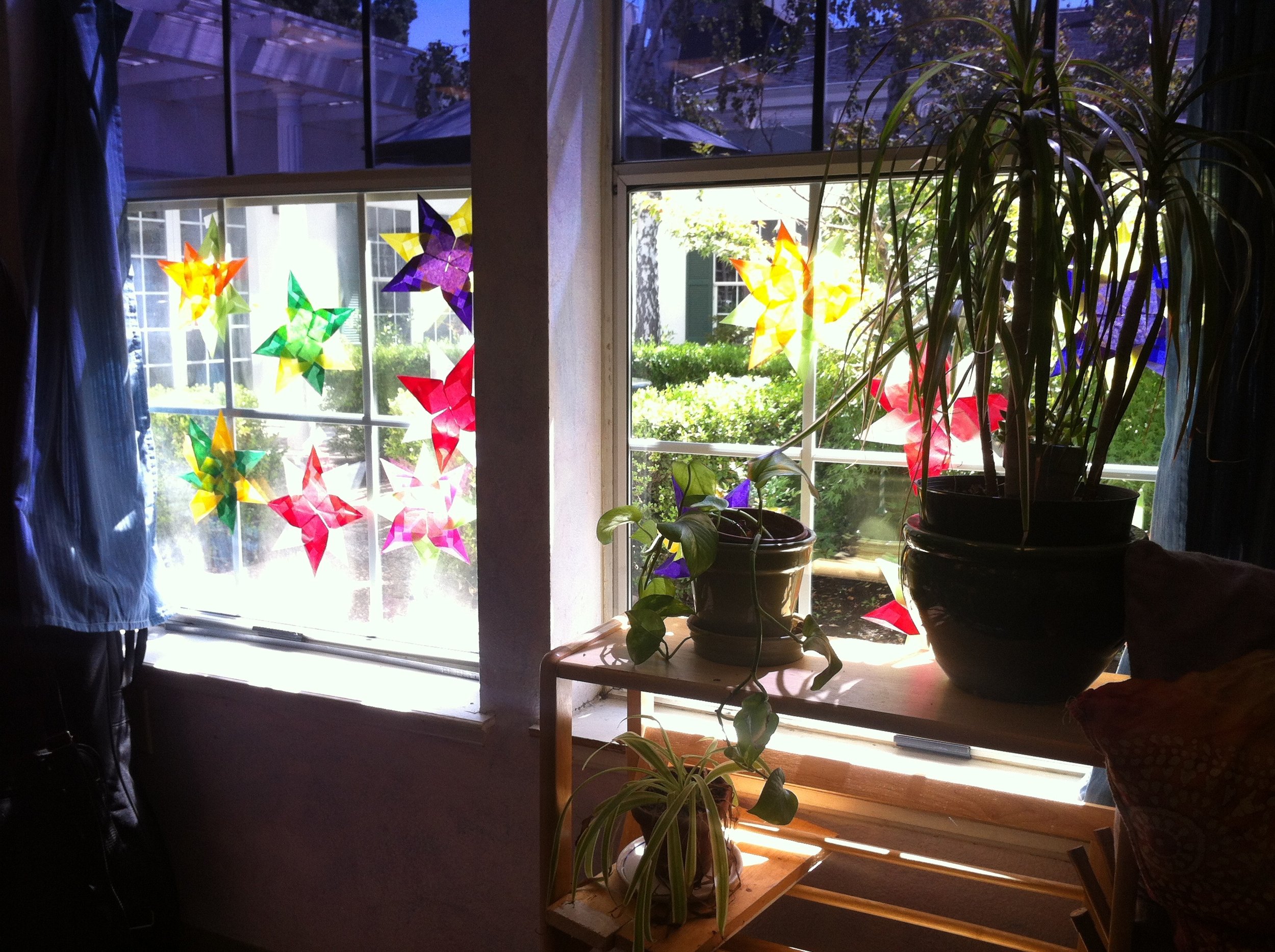 The next step was to create beautiful paper stars. Students were all given exactly cut paper, directions, and put in groups of twos to create these wonderful stars to decorate our classroom. First, I modeled the folding with them all gathered around, then I set them to work reading the steps, and working their way through the 'rules' of folding. These very specific, repetitive folds required great precision, for if your points weren't crisp, your star wouldn't be symmetrical. As you can see, most of the students had great success! We also had beautiful rainbow light filtering into the room for weeks.After experiencing the importance of rules bodily, and precision in beauty, it was time to dive into the tools. Each student was gifted a beautiful draftsman compass. They also had rulers from their third-grade block on measurement. We began by just playing with them! We drew caterpillars. Looking back from 8th grade, the kids still marvel at how hard those first circles were. After playing, many of the discovered the Rules of Play themselves, i.e. how to hold the compass so it didn't skip, how to set the compass to a specific width, how to turn the compass and not the paper, that for some kids, standing over their paper yielded greater success than sitting at the desk. Together, we discussed, and formalized these rules.
The next step was to create beautiful paper stars. Students were all given exactly cut paper, directions, and put in groups of twos to create these wonderful stars to decorate our classroom. First, I modeled the folding with them all gathered around, then I set them to work reading the steps, and working their way through the 'rules' of folding. These very specific, repetitive folds required great precision, for if your points weren't crisp, your star wouldn't be symmetrical. As you can see, most of the students had great success! We also had beautiful rainbow light filtering into the room for weeks.After experiencing the importance of rules bodily, and precision in beauty, it was time to dive into the tools. Each student was gifted a beautiful draftsman compass. They also had rulers from their third-grade block on measurement. We began by just playing with them! We drew caterpillars. Looking back from 8th grade, the kids still marvel at how hard those first circles were. After playing, many of the discovered the Rules of Play themselves, i.e. how to hold the compass so it didn't skip, how to set the compass to a specific width, how to turn the compass and not the paper, that for some kids, standing over their paper yielded greater success than sitting at the desk. Together, we discussed, and formalized these rules.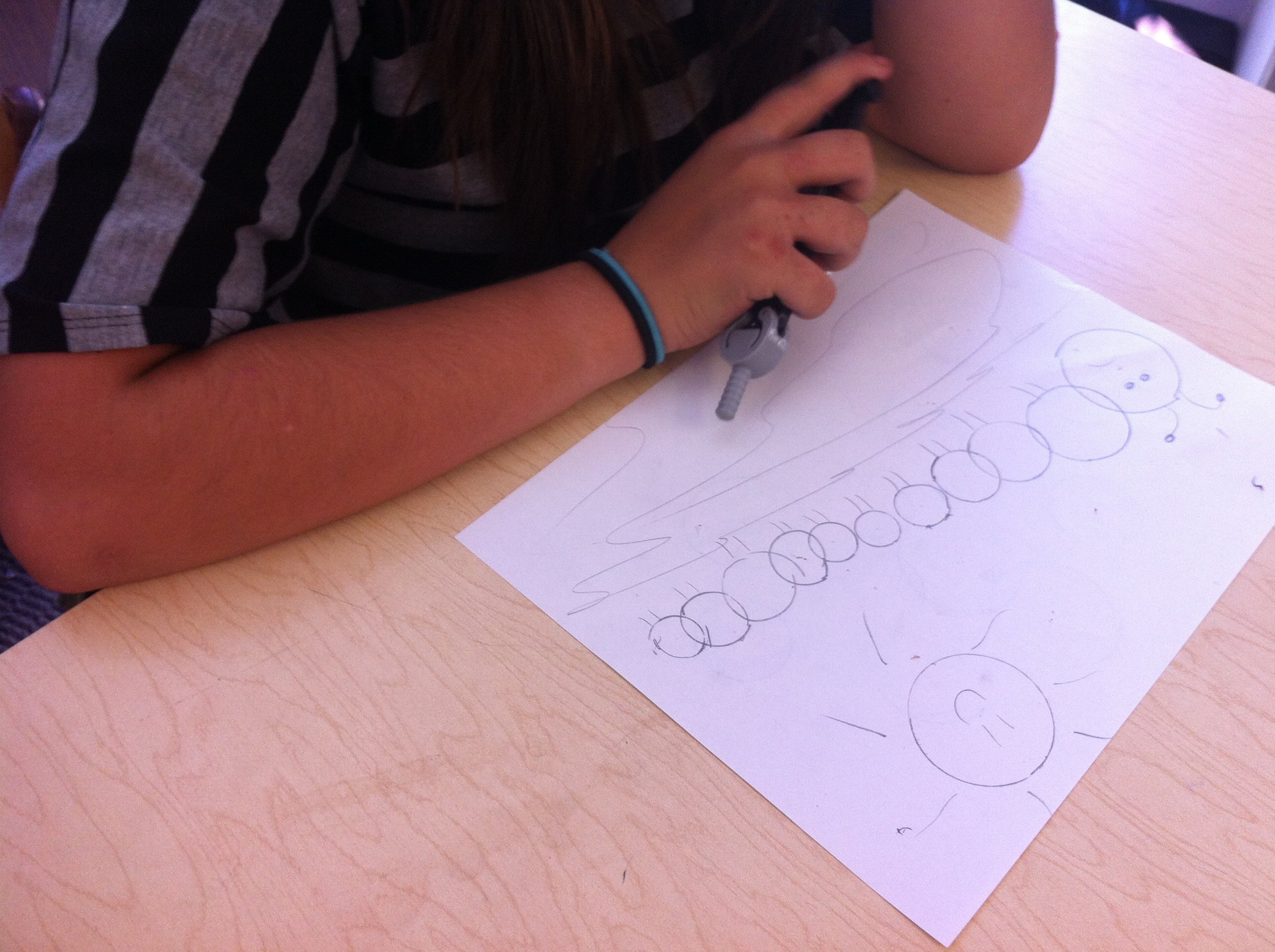 Lastly, after all this build-up, the first lesson was given. The Radius, and the Circumference. I began with story the day before. I told them an elaborate story about a wild horse who ran through the plains and forest, freely! How she loved the wind blowing through her hair, the soft loamy soil under her hooves, the smell of the torn up dirt as she raced through, etc. I made certain to add pieces to affect each temperament. (Side note: my SUPER phelgmatic, dreamy child was the biggest challenge. I met her as the horse ran past a cottage window, where inside the farmer's wife was roasting chickens. I remember describing the juices and smells, and pops and crackles to great detail with this specific student in mind. She actually lipped her lips, and muttered "mmm...chicken"!)Finally, the horse was captured by strong workers of the frontier. A rope was placed around her neck, and she was staked down in a field. She would run as straight and hard as she could directly out from that stake, trying to yank it from the ground, but alas, it was strong. She would go back to the center, and try to pry it with a hoof, then bolt directly out again, and again and again! (See the idea of RADIUS building?)The next day, she found the farthest she could get away from that stake. From that point, she ran as hard as she could, trying to wind the stake out of the ground. Around, and around, and around she'd go, wearing a track into the field at the end of the rope, all the way around in a circle, as far away from the stake as she could. (See the CIRCUMFERENCE?)When she awoke the next day, the men had been working all night. They had built a square fence touching the outside track she had made. She learned that if she ran to the fence-posts, she could just barely touch them with her nose as the rope got tight, but if she ran at the middle of the fence, she could jump and land on the other side, free! but still tethered. (SQUARE INSCRIBED WITHIN THE CIRCLE)When she awoke the next day, the men had build another fence! This time, the area was much greater within the fence. Out just a ways from where the middle of the fence was, they had driven a post, and connected it on both all sides to the previous posts. They had also removed yesterday's fence railings. Now, if she ran at the center of the railing, she would feel the rope tighten just as she reached it. If she ran at the corners, the rope would tighten much too early, and she would never touch the posts. (CIRCLE INSCRIBED WITHIN THE SQUARE)One morning, after many days of wandering around inside her paddock, still tethered, the men finally removed the rope! She looked around and saw that no matter how hard she had wanted to, she couldn't ever reach those corners, and all the grass inside her rope area had been trampled flat, leaving a circle of bare ground. Now, without the rope, she could eat the fresh, untouched grass near the corners of the fence (AREA OF A CIRCLE). After a few days of enjoying this new freedom, and roaming to all parts of the paddock, she had finally eaten all the grass
Lastly, after all this build-up, the first lesson was given. The Radius, and the Circumference. I began with story the day before. I told them an elaborate story about a wild horse who ran through the plains and forest, freely! How she loved the wind blowing through her hair, the soft loamy soil under her hooves, the smell of the torn up dirt as she raced through, etc. I made certain to add pieces to affect each temperament. (Side note: my SUPER phelgmatic, dreamy child was the biggest challenge. I met her as the horse ran past a cottage window, where inside the farmer's wife was roasting chickens. I remember describing the juices and smells, and pops and crackles to great detail with this specific student in mind. She actually lipped her lips, and muttered "mmm...chicken"!)Finally, the horse was captured by strong workers of the frontier. A rope was placed around her neck, and she was staked down in a field. She would run as straight and hard as she could directly out from that stake, trying to yank it from the ground, but alas, it was strong. She would go back to the center, and try to pry it with a hoof, then bolt directly out again, and again and again! (See the idea of RADIUS building?)The next day, she found the farthest she could get away from that stake. From that point, she ran as hard as she could, trying to wind the stake out of the ground. Around, and around, and around she'd go, wearing a track into the field at the end of the rope, all the way around in a circle, as far away from the stake as she could. (See the CIRCUMFERENCE?)When she awoke the next day, the men had been working all night. They had built a square fence touching the outside track she had made. She learned that if she ran to the fence-posts, she could just barely touch them with her nose as the rope got tight, but if she ran at the middle of the fence, she could jump and land on the other side, free! but still tethered. (SQUARE INSCRIBED WITHIN THE CIRCLE)When she awoke the next day, the men had build another fence! This time, the area was much greater within the fence. Out just a ways from where the middle of the fence was, they had driven a post, and connected it on both all sides to the previous posts. They had also removed yesterday's fence railings. Now, if she ran at the center of the railing, she would feel the rope tighten just as she reached it. If she ran at the corners, the rope would tighten much too early, and she would never touch the posts. (CIRCLE INSCRIBED WITHIN THE SQUARE)One morning, after many days of wandering around inside her paddock, still tethered, the men finally removed the rope! She looked around and saw that no matter how hard she had wanted to, she couldn't ever reach those corners, and all the grass inside her rope area had been trampled flat, leaving a circle of bare ground. Now, without the rope, she could eat the fresh, untouched grass near the corners of the fence (AREA OF A CIRCLE). After a few days of enjoying this new freedom, and roaming to all parts of the paddock, she had finally eaten all the grass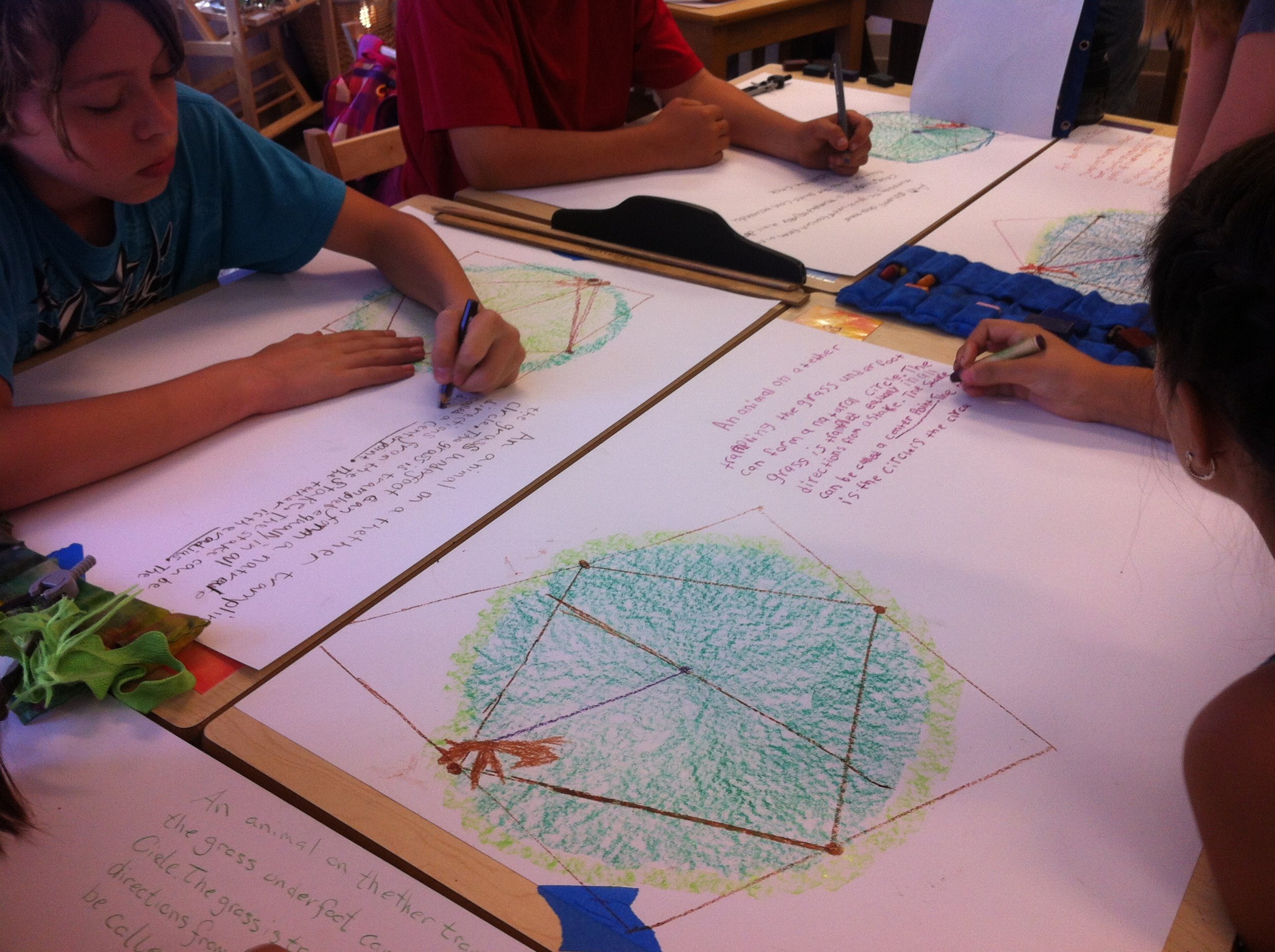 , and trampled it all flat (AREA OF A SQUARE).NOTE: This was a two-day story. If I remember, I broke it at the first fence, with story recapitulation in between.Now, after experiencing rules, and precision, and playful exploration, and imaginative storytelling, finally, we were ready to put our thoughts to paper. You can see all the elements of the story coming to light in their drawing. They are also writing a dictation which contains all the vocabulary (underlined).From here, they were ready to begin Euclidian geometry. We worked through the hexagon in it's various permutations and inscribed forms, the dodecagon (learning to bisect lines), and the pentagon similarly. Always through artwork, and often through movement. I remember dancing in a 5-pointed star. We also took walks to find the 6 and 5 in nature. We did a few activities in different types of spirals (Archimedean and Logarithmic), we discussed how nature builds upon these rules of geometry, and lastly, with an example of the Calla Lilly leaf, how the triangle fits within these forms (see Live Education).
, and trampled it all flat (AREA OF A SQUARE).NOTE: This was a two-day story. If I remember, I broke it at the first fence, with story recapitulation in between.Now, after experiencing rules, and precision, and playful exploration, and imaginative storytelling, finally, we were ready to put our thoughts to paper. You can see all the elements of the story coming to light in their drawing. They are also writing a dictation which contains all the vocabulary (underlined).From here, they were ready to begin Euclidian geometry. We worked through the hexagon in it's various permutations and inscribed forms, the dodecagon (learning to bisect lines), and the pentagon similarly. Always through artwork, and often through movement. I remember dancing in a 5-pointed star. We also took walks to find the 6 and 5 in nature. We did a few activities in different types of spirals (Archimedean and Logarithmic), we discussed how nature builds upon these rules of geometry, and lastly, with an example of the Calla Lilly leaf, how the triangle fits within these forms (see Live Education).